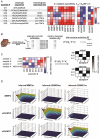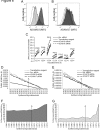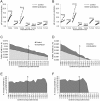Modification of proteolytic activity matrix analysis (PrAMA) to measure ADAM10 and ADAM17 sheddase activities in cell and tissue lysates
- PMID: 29187866
- PMCID: PMC5705993
- DOI: 10.7150/jca.20779
Modification of proteolytic activity matrix analysis (PrAMA) to measure ADAM10 and ADAM17 sheddase activities in cell and tissue lysates
Abstract
Increases in expression of ADAM10 and ADAM17 genes and proteins have been evaluated, but not validated as cancer biomarkers. Specific enzyme activities better reflect enzyme cellular functions, and might be better biomarkers than enzyme genes or proteins. However, no high throughput assay is available to test this possibility. Recent studies have developed the high throughput real-time proteolytic activity matrix analysis (PrAMA) that integrates the enzymatic processing of multiple enzyme substrates with mathematical-modeling computation. The original PrAMA measures with significant accuracy the activities of individual metalloproteinases expressed on live cells. To make the biomarker assay usable in clinical practice, we modified PrAMA by testing enzymatic activities in cell and tissue lysates supplemented with broad-spectrum non-MP enzyme inhibitors, and by maximizing the assay specificity using systematic mathematical-modeling analyses. The modified PrAMA accurately measured the absence and decreases of ADAM10 sheddase activity (ADAM10sa) and ADAM17sa in ADAM10-/- and ADAM17-/- mouse embryonic fibroblasts (MEFs), and ADAM10- and ADAM17-siRNA transfected human cancer cells, respectively. It also measured the restoration and inhibition of ADAM10sa in ADAM10-cDNA-transfected ADAM10-/- MEFs and GI254023X-treated human cancer cell and tissue lysates, respectively. Additionally, the modified PrAMA simultaneously quantified with significant accuracy ADAM10sa and ADAM17sa in multiple human tumor specimens, and showed the essential characteristics of a robust high throughput multiplex assay that could be broadly used in biomarker studies. Selectively measuring specific enzyme activities, this new clinically applicable assay is potentially superior to the standard protein- and gene-expression assays that do not distinguish active and inactive enzyme forms.
Keywords: ADAM10; ADAM17; Cancer biomarker; Cell lysate; Fluorogenic peptide substrates; Gene knockout; Gene restoration; Gene silence; Protease inhibitors; Proteolytic activity matrix analysis; Sheddase activity; Tissues; lysate.
Conflict of interest statement
Competing Interests: The authors have declared that no competing interest exists.
Figures








Similar articles
-
ADAM10 Sheddase Activity is a Potential Lung-Cancer Biomarker.J Cancer. 2018 Jun 23;9(14):2559-2570. doi: 10.7150/jca.24601. eCollection 2018. J Cancer. 2018. PMID: 30026855 Free PMC article.
-
Proteolytic Activity Matrix Analysis (PrAMA) for simultaneous determination of multiple protease activities.Integr Biol (Camb). 2011 Apr;3(4):422-38. doi: 10.1039/c0ib00083c. Epub 2010 Dec 23. Integr Biol (Camb). 2011. PMID: 21180771 Free PMC article.
-
Simultaneous Detection of Metalloprotease Activities in Complex Biological Samples Using the PrAMA (Proteolytic Activity Matrix Assay) Method.Methods Mol Biol. 2017;1574:243-253. doi: 10.1007/978-1-4939-6850-3_18. Methods Mol Biol. 2017. PMID: 28315256
-
Metalloproteinase inhibitors for the disintegrin-like metalloproteinases ADAM10 and ADAM17 that differentially block constitutive and phorbol ester-inducible shedding of cell surface molecules.Comb Chem High Throughput Screen. 2005 Mar;8(2):161-71. doi: 10.2174/1386207053258488. Comb Chem High Throughput Screen. 2005. PMID: 15777180 Review.
-
The good, the bad and the ugly substrates for ADAM10 and ADAM17 in brain pathology, inflammation and cancer.Semin Cell Dev Biol. 2009 Apr;20(2):164-74. doi: 10.1016/j.semcdb.2008.09.005. Epub 2008 Sep 18. Semin Cell Dev Biol. 2009. PMID: 18951988 Review.
Cited by
-
ADAM10 Sheddase Activity is a Potential Lung-Cancer Biomarker.J Cancer. 2018 Jun 23;9(14):2559-2570. doi: 10.7150/jca.24601. eCollection 2018. J Cancer. 2018. PMID: 30026855 Free PMC article.
-
Development of flow cytometry assays for measuring cell-membrane enzyme activity on individual cells.J Cancer. 2020 Jan 1;11(3):702-715. doi: 10.7150/jca.30813. eCollection 2020. J Cancer. 2020. PMID: 31942194 Free PMC article.
References
-
- Saftig P, Reiss K. The “A Disintegrin And Metalloproteases” ADAM10 and ADAM17: Novel drug targets with therapeutic potential? European J. Cell Biol. 2011;90:527–35. - PubMed
-
- Black RA. Tumor necrosis factor-alpha converting enzyme. Int J Biochem Cell Biol. 2002;34:1–5. - PubMed
-
- Black RA, Rauch CT, Kozlosky CJ. et al. A metalloproteinase disintegrin that releases tumour-necrosis factor-[alpha] from cells. Nature. 1997;385:729–33. - PubMed
-
- Moss ML, Jin SL, Milla ME. et al. Cloning of a disintegrin metalloproteinase that processes precursor tumour-necrosis factor-alpha. Nature. 1997;385:733–6. - PubMed
-
- Lee DC, Sunnarborg SW, Hinkle CL. et al. TACE/ADAM17 Processing of EGFR ligands indicates a role as a physiological convertase. Ann N Y Acad Sci. 2003;995:22–38. - PubMed
Grants and funding
LinkOut - more resources
Full Text Sources
Other Literature Sources
Miscellaneous

